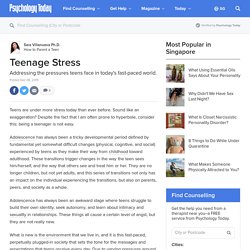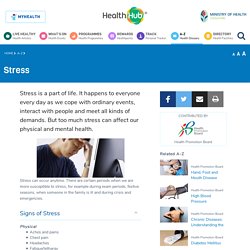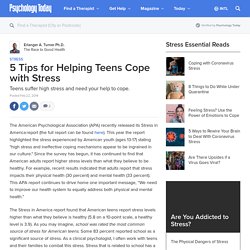

Psychology Today Singapore. Teens are under more stress today than ever before.

Sound like an exaggeration? Despite the fact that I am often prone to hyperbole, consider this: being a teenager is not easy. Adolescence has always been a tricky developmental period defined by fundamental yet somewhat difficult changes (physical, cognitive, and social) experienced by teens as they make their way from childhood toward adulthood. These transitions trigger changes in the way the teen sees him/herself, and the way that others see and treat him or her. They are no longer children, but not yet adults, and this series of transitions not only has an impact on the individual experiencing the transitions, but also on parents, peers, and society as a whole. article continues after advertisement Adolescence has always been an awkward stage where teens struggle to build their own identity, seek autonomy, and learn about intimacy and sexuality in relationships.
So, why are teens so “angsty” today? What can parents do? Signs and Symptoms of Stress. Signs You’re Too Stressed Out. Some stress is normal, but too much of it isn’t.

What are the warning signs of stress that tell us we’re overly stressed out? There’s No Avoiding Stress We can’t avoid certain stressful situations: never-ending deadlines, your child’s PSLEs, increasing cost of living ($2 for a prata? Daylight robbery!) , and an MRT breakdown that derails your entire day. Fret not, stress is an essential part of life— without it, we wouldn’t be motivated to face challenges. When does stress cross the line to become harmful to our wellbeing? Related: Stress-O-S! When the Kan Cheong Spider Bites Being a kan cheong spider - constantly feeling hurried and anxious - can cause stress which becomes harmful when it gets in the way of daily life, whether health, relationships or work.
Here’s a possible scenario: say we’re trying to be healthier. For example, we might stress-eat on an entire tub of ice cream after a terrible day. Or we might give up our workout routine because we’re overwhelmed by work. Top 6 Causes of Teen Stress and Pressure. Teens growing up today encounter many common sources of stress, including social, psychological, and societal pressures.

As they transition from childhood to adulthood, face increasing responsibilities and decisions that can both be empowering, but also provoke much anxiety. Depending on their circumstances, some teens may be better equipped to deal with these stresses than others. That’s why both positive peer support and adult role models are very important around this age. 1.
Mental illness Growing up, teenagers experience new external and internal struggles that can be emotionally overwhelming. 2. All people naturally want to fit in and be liked by others, but adolescents feel this pressure intensely. 3. The stress and anxiety of academics can be challenging for youth to effectively manage. 4. Stress. External sources of stress could include: Personal problemsWork problemsRelationship difficultiesPressure of studiesHealth problemsFinancial crisisUnemploymentLosses, e.g. bereavementUnexpected newsDaily hassles Internal sources of stress could include the following: Thinking stylesNegativity: "I'm useless, a loser, a failure.

"Suspicion: "Why are they so nice to me? " Examining Social Anxiety Among Adolescents in Accordance with coping stress approaches. Fight Flight Freeze – Anxiety Explained For Teens. 5 Tips for Helping Teens Cope with Stress. The American Psychological Association (APA) recently released its Stress in America report (the full report can be found here).

This year the report highlighted the stress experienced by American youth (ages 13-17) stating "high stress and ineffective coping mechanisms appear to be ingrained in our culture. " Since the survey has begun, it has continued to find that American adults report higher stress levels than what they believe to be healthy. For example, recent results indicated that adults report that stress impacts their physical health (30 percent) and mental health (33 percent). This APA report continues to drive home one important message, “We need to improve our health system to equally address both physical and mental health.” article continues after advertisement The Stress in America report found that American teens report stress levels higher than what they believe is healthy (5.8 on a 10-point scale, a healthy level is 3.9).
Coping with Stress. Patterns of Spiritual Connectedness during Adolescence Links to coping and adjustment in low income urban youth. Behavioral and Psychophysiological Effects of a Yoga Intervention on High Risk Adolescents A Randomized Control Trial.